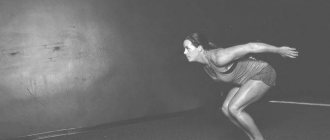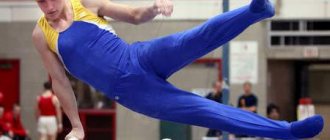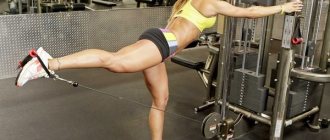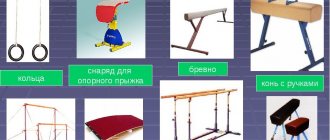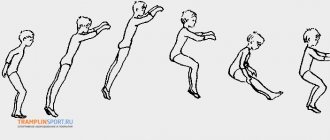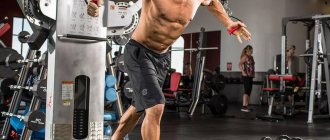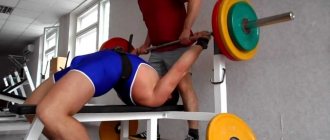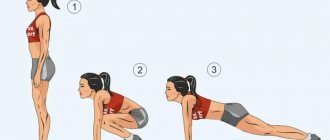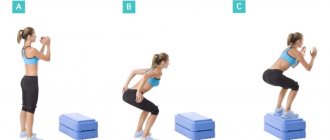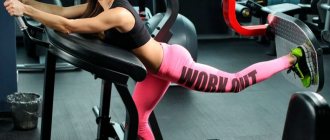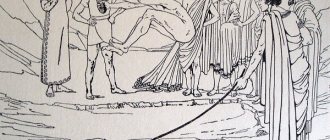Benefits of exercise
Despite its simplicity, an unsupported or supported jump provides a number of advantages. In artistic gymnastics, their mastery is mandatory, since jumps are among the basic and competitive elements.
Main benefits:
- Strengthening tendons and ligaments.
- Involvement of all muscles of the body.
- Development of movement coordination.
- Increased agility and body control.
- Preparing the musculoskeletal system to perform powerful and fast movements (including landings with strong shock absorption).
- Developing courage and determination to overcome assigned sports challenges.
In general, the vault over the goat is used as a springboard for the physical and technical development of more complex elements.
Olympiad tasks in physical education for grades 7-8
Theoretical and methodological tasks (closed form)
- In what year was the International Olympic Committee created?
a) 1898;
b) 1911;
c) 1923;
d) 1894
- The five intertwined rings are:
a) Olympic symbol;
b) Olympic emblem;
c) Olympic medal;
d) Olympic memory.
- Which option correctly states the Olympic motto?
a) “Bolder, higher, stronger”;
b) “Through labor and perseverance to the Glory of the Motherland”;
c) “Faster, higher, stronger”;
d) “Sport, health, joy.”
- The first Olympic champion of Russia was:
a) Figure skater Nikolai Panin-Kolomensky;
b) Gymnast Olga Korbut;
c) Wrestler Nikolai Orlov;
d) Sergey Chelikov.
- The first Olympic champion of the Soviet Union was:
a) Svetlana Zhurova;
b) Nina Ponomareva;
c) Lydia Skoblikova;
d) Lyudmila Turishcheva.
- What is posture?
a) silhouette of a person;
b) the usual posture of a person in an upright position;
c) artificially created human posture by muscle tension;
d) beautiful, straight back.
- What do we mean by the expression “hardening the body”?
a) disease prevention;
b) a combination of sunbathing and outdoor games;
c) gradual increase in the resistance of the human body to the effects of adverse environmental factors;
d) improving health by swimming in an ice hole.
- Take-off, push, flight phase, landing - these are the elements of technology:
a) throwing the ball at a target at a distance;
b) standing long jump;
c) running long jump;
d) high jump.
- Speed is determined using:
a) running long jump;
b) 30 m and 60 m races;
c) 100 m race;
d) long distance running.
- In which sport can a dropped ball be worth one, two or three points?
a) volleyball;
b) handball;
basketball;
d) football.
- What are the names of sports that involve several disciplines?
a) complex;
b) all-around;
c) triplex;
d) integral.
- Lack of warm-up before competition (or before the main load in training) most often leads to:
a) saving energy;
b) improving sports results;
c) injuries.
- When a runner exits from a low start, the error is:
a) strong kicking;
b) different hands work;
c) lowered head;
d) rapid straightening of the body.
- The length of the marathon running distance is:
a) 42 km 195 m;
b) 40 km 190 m;
c) 32 km 180 m;
d) 30 km.
- How many players of one team can be on the field at the same time in football?
a) 11;
b) 9;
c) 15;
d) 7.
- To improve your overall health, what physical quality should you pay the most attention to?
a) speed;
b) endurance;
c) dexterity;
d) flexibility.
- In what sport did Maria Sharapova, Svetlana Kuznetsova, Mikhail Youzhny, Nikolay Davydenko prove themselves?
a) athletics;
b) tennis;
c) swimming;
d) artistic gymnastics.
- What, first of all, should be done when providing first aid to a victim of a bruise of any part of the body on a hard surface?
a) treat the bruised area with iodine;
b) apply heat to the injured area;
c) apply a splint;
d) cool the bruised area.
- What is the correct terminological name for “jumping over a goat?”
a) long jump;
b) high jump;
c) vault;
d) depth jump.
- Which picture shows the “Front Angle” position?
Open-ended tasks
Complete the statement by writing the appropriate word on the answer sheet
- Scoliosis is a lateral curvature...
- The program of physical training of the population for various age groups of the population is called ...
- In what athletics discipline did Olympic champion Elena Isinbaeva compete? ...
- A set of physical exercises that ensures a gradual transition from sleep to wakefulness is called....
- A sports game on a grass field in which two opposing teams of 11 people participate is called...
SCHOOL OLYMPIAD
in the subject "physical culture"
7-8 grades
ANSWER FORM
Full Name _________________________________________________________
School, class _____________________________________________________________________
| № | Answer options | № | Answer options | |||||||||||||
| question | question | |||||||||||||||
| Open-ended tasks | ||||||||||||||||
| 1 | A | b | V | G | 16 | A | b | V | G | |||||||
| 2 | A | b | V | G | 17 | A | b | V | G | |||||||
| 3 | A | b | V | G | 18 | A | b | V | G | |||||||
| 4 | A | b | V | G | 19 | A | b | V | G | |||||||
| 5 | A | b | V | G | 20 | A | b | V | G | |||||||
| 6 | A | b | V | G | ||||||||||||
| 7 | A | b | V | G | ||||||||||||
| 8 | A | b | V | G | ||||||||||||
| 9 | A | b | V | G | ||||||||||||
| 10 | A | b | V | G | ||||||||||||
| 11 | A | b | V | G | ||||||||||||
| 12 | A | b | V | G | ||||||||||||
| 13 | A | b | V | G | ||||||||||||
| 14 | A | b | V | G | ||||||||||||
| 15 | A | b | V | G | ||||||||||||
| 21 | Open-ended tasks | ||||||||
| 22 | |||||||||
| 23 | |||||||||
| 24 | |||||||||
25
___________________________________
Number of correct answers
______________
Options for correct answers
1. In what year was the International Olympic Committee created?
a) 1898;
b) 1911;
c) 1923;
d) 1894
- The five intertwined rings are:
a) Olympic symbol;
b) Olympic emblem;
c) Olympic medal;
d) Olympic memory.
- Which option correctly states the Olympic motto?
a) “Bolder, higher, stronger”;
b) “Through labor and perseverance to the Glory of the Motherland”;
c) “Faster, higher, stronger”;
d) “Sport, health, joy.”
- The first Olympic champion of Russia was:
a) Figure skater Nikolai Panin-Kolomensky;
b) Gymnast Olga Korbut;
c) Wrestler Nikolai Orlov;
d) Sergey Chelikov.
- The first Olympic champion of the Soviet Union was:
a) Svetlana Zhurova;
b) Nina Ponomareva;
c) Lydia Skoblikova;
d) Lyudmila Turishcheva.
- What is posture?
a) silhouette of a person;
b) the usual posture of a person in an upright position;
c) artificially created human posture by muscle tension;
d) beautiful, straight back.
- What do we mean by the expression “hardening the body”?
a) disease prevention;
b) a combination of sunbathing and outdoor games;
c) gradual increase in the resistance of the human body to the effects of adverse environmental factors;
d) improving health by swimming in an ice hole.
- Take-off, push, flight phase, landing - these are the elements of technology:
a) throwing the ball at a target at a distance;
b) standing long jump;
c) running long jump;
d) high jump.
- Speed is determined using:
a) running long jump;
b) 30 m and 60 m races;
c) 100 m race;
d) long distance running.
- In which sport can a dropped ball be worth one, two or three points?
a) volleyball;
b) handball;
basketball;
d) football.
- What are the names of sports that involve several disciplines?
a) complex;
b) all-around;
c) triplex;
d) integral.
- Lack of warm-up before competition (or before the main load in training) most often leads to:
a) saving energy;
b) improving sports results;
c) injuries.
- When a runner exits from a low start, the error is:
a) strong kicking;
b) different hands work;
c) lowered head;
d) rapid straightening of the body.
- The length of the marathon running distance is:
a) 42 km 195 m;
b) 40 km 190 m;
c) 32 km 180 m;
d) 30 km.
- How many players of one team can be on the field at the same time in football?
a) 11;
b) 9;
c) 15;
d) 7.
- To improve your overall health, what physical quality should you pay the most attention to?
a) speed;
b) endurance;
c) dexterity;
d) flexibility.
- In what sport did Maria Sharapova, Svetlana Kuznetsova, Mikhail Youzhny, Nikolay Davydenko prove themselves?
a) athletics;
b) tennis;
c) swimming;
d) artistic gymnastics.
- What, first of all, should be done when providing first aid to a victim of a bruise of any part of the body on a hard surface?
a) treat the bruised area with iodine;
b) apply heat to the injured area;
c) apply a splint;
d) cool the bruised area.
- What is the correct terminological name for “jumping over a goat?”
a) long jump;
b) high jump;
c) vault;
d) depth jump.
- Which picture shows the “Sided angle” position?
Answer #2
Answer options for open-ended tasks
Complete the statement by writing the appropriate word on your answer sheet.
- Scoliosis is a lateral curvature...
Answer: Spine
- The program of physical training of the population for various age groups of the population is called ...
Answer: GTO
- In what athletics discipline did Olympic champion Elena Isinbaeva compete? ...
Answer: Pole vault
- A set of physical exercises that ensures a gradual transition from sleep to wakefulness is called....
Answer: Morning exercises
- A sports game on a grass field in which two opposing teams of 11 people participate is called...
Answer: Football
Phases of performing a vault
There are several types of jumping over a horse or goat, although they all have similar mechanics and movement phases. Mastering any type of jump is almost guaranteed to make other techniques easier to perform.
Vault phases:
- Take-off – the distance and speed of take-off depend on the height of the projectile. When performing complex techniques or unsupported jumps, the run-up distance increases significantly.
- Leap onto the bridge - carried out while reaching maximum speed. This contributes to inertial pushing and successful completion of the distance. extremely important to work with a pushing leg and accurately hit the place of the push.
- The push is an explosive element that is accompanied by swinging the arms up and forward.
- Flight is the flight phase after the push. In this phase it is important to have a steep trajectory and a slightly bent body position.
- The push with the hands is the key and most difficult phase. The push ends when the legs cross the vertical area of the supporting surface.
- Flight after repulsion - the technique depends on the type of projectile.
- Landing – requires a tuck (if you relax during landing, your balance will be worse). It is carried out by quickly rolling from the toe to the full foot. In this case, the socks are spread apart, the heels are held together.
How is an angled jump over a horse performed with a swing of one and a push of the other?
When jumping at an angle
to the right with a slight run-up, swinging your right leg, lean your right hand on the
horse’s
and push off with your left foot on the bridge. Connect your legs above the apparatus and place your left hand next to your right. After this, releasing your right hand and continuing to lean with your left, land with your left side to the horse.
Interesting materials:
How much litter should I put in my cat's litter box? How long should you not shave before Sugaring? How long should you not wash your hands after a manicure? How long can you not exercise after dental implantation? How long can you not exercise after a sinus lift? How long do you wear Smad? How long to wear underwear after mammoplasty? How long to wear a black scarf after the death of your mother? How long to wear a cast after an ankle fracture? How long to wear compression after phlebectomy?
Preparation before execution: warm-up
Preparation is divided into two types - direct mastery of the technique of performing a vault, as well as warming up before performing the movement.
To improve and master the technique, a number of exercises are performed:
- Mastering the run-up - an athlete learns to perform a run-up. To do this, elements such as running in place (with a high hip lift), without with variable acceleration, imitation of arm movements, and others are performed.
- Jump onto the bridge - a series of jumps is performed while holding the projectile, at a height, on one leg.
- Mastering flight after take-off - performed with a partner or landing on mats.
- Push - jumping out of place, with a slight run-up, jumping back, pushing off with hands while standing against the wall.
- Mastering flight and landing - a series of jumps at different heights, half-squats and other exercises are used.
The immediate warm-up before performing the exercise includes a full range of movements. It starts with the hands, neck and shoulders with a gradual decrease until the feet are warmed up. Read more about warming up →
Stretching at this stage is excluded, as it can negatively affect not only performance, but also the risk of injury.
How is the run-up length measured in the running long jump?
Running long jump
.
running long
jump is performed in the appropriate jumping sector.
The measurement
is taken along a perpendicular straight line from the nearest mark left by any part of the participant’s body to the take-off line. The participant is given three attempts. The best result counts.
Interesting materials:
What happened to Sergei Safronov? What happened to Buzova and David? What do you add alcohol or water first? What is added to the soup first? Which comes first: micellar water or cleansing gel? What is accounting? What should a friend pack for her box? What goes with banana? What goes with red fish? What goes with pizza?
Execution technique
There are several types of techniques in which the phases depend on the position of the projectile.
Long vault jump over goat
The support jump of the legs apart over the goat is performed as follows:
- A run-up is performed, followed by a powerful kick with the legs. It is carried out simultaneously with putting your hands forward (to the place of support in the far part of the projectile).
- The body rises above the horizontal. After this, pressure is applied with both hands on the goat, bending the body and spreading the legs to the side.
- After taking off, you need to fix the deflection of the body, then raise your arms up and land.
The support jump with legs apart is considered the simplest option, therefore it is ideal for later mastering more complex elements. Performed when setting the horse in length.
Jump over a goat set wide
If the projectile is set wide, the legs are folded together and moved forward when positioned above the scanner. The landing phase is the same regardless of the technique used.
When performing an unsupported jump, the springboard may or may not be used. First, a powerful long run-up with repulsion is performed, after which the projectile flies without transferring the center of gravity to the hands. It is considered more complex than other types.
Technique for performing a jump over a goat in physical education
We all remember physical education lessons from our school years. Various topics: volleyball, football, throwing, push-ups, gymnastic jumps, etc. One of the most famous such exercises is jumping over a gymnastic apparatus. This exercise is called jumping over a “goat” or “horse”. The simulator in question is a surface covered with leather; the projectile legs are made of steel. The height of the “horse” varies from 90 cm to 130 centimeters. This simulator can withstand up to 100 kg. Like other workouts in school physical education, jumping over a goat develops all the muscles of the body as a whole. This exercise also has a beneficial effect on the heart muscle, being a good cardio load. Also, jumping over a “goat” develops the student’s moral and volitional qualities, such as determination, courage and courage.
All school curriculum standards
In physical education classes in many classes, children pass standards for jumping technique
In order to start performing a jump, you need to warm up and warm up your muscles well, otherwise the situation may result in injury. Slow running, body turns, jumping rope and squats are suitable for warming up. The gymnastic “horse” is set in width or length, this will determine the running distance. In order to perform the exercise correctly and safely, you need to know all the stages of its execution; we will consider each in more detail.
Technique for jumping over a goat
- Take-off run. The take-off distance is approximately 10 meters. The take-off run is carried out smoothly, without a sharp increase in speed.
- Leap onto the bridge. The bridge is a spring surface that helps you jump onto the “goat”. The pounce is done at maximum acceleration. It is forbidden to slow down before jumping onto this plane. Usually the bridge and the “horse” are placed a meter from each other.
- Pushing off the bridge with your feet. When jumping onto the bridge, you must land on your toes, while your feet should be parallel to each other, and your legs should be tense. When pushing from the bridge onto the “horse,” you need to tilt your body a little forward, round your back and straighten your knees while jumping.
- Flight. At this stage of training, the student must touch the apparatus with his hands. A jerk is performed in which the shoulders move upward, the arms become straight, and the wrists bend. To make the jump higher, it is very important to combine a jerk of the body and a push with the arms, this will provoke the lifting of the pelvis and stopping of the legs.
- Flight after the jump. This is perhaps the most significant stage of the exercise, since after it the student is graded.
- Landing. To avoid falling, you need to land on your toes and immediately stand on your feet. In order to make the landing softer, you need to bend your legs slightly. After all, a hard landing can cause injury.
Safety precautions for such an exercise come down to several main rules: it is forbidden to perform a jump without the teacher’s command, you must perform the jump with a safety net, land only on bent legs, and to avoid injury there must be a gymnastic mat on the floor.
It happens that schoolchildren make some mistakes when performing such an exercise. Let's consider typical ones: prolonged support with the arms and a jerk under oneself; in flight, after a push with the arms, extension in the hip joints does not occur.
Having examined all the stages of performing a jump over a “goat,” we can conclude that their sequence is simple and equally important, so making a mistake in any one phase can ruin the entire exercise. In some schools, due to the risk of injury, the lesson on jumping over the “goat” was canceled. However, there are educational institutions where this exercise remains mandatory after the 4th grade. There is an opinion that some students are embarrassed to perform such an exercise, afraid of doing something wrong: starting the run at the wrong speed, not jumping enough, missing or falling. However, with a competent approach from the teacher and compliance with safety precautions, such an exercise is very useful not only for the physical education of schoolchildren, but also for the moral one.
